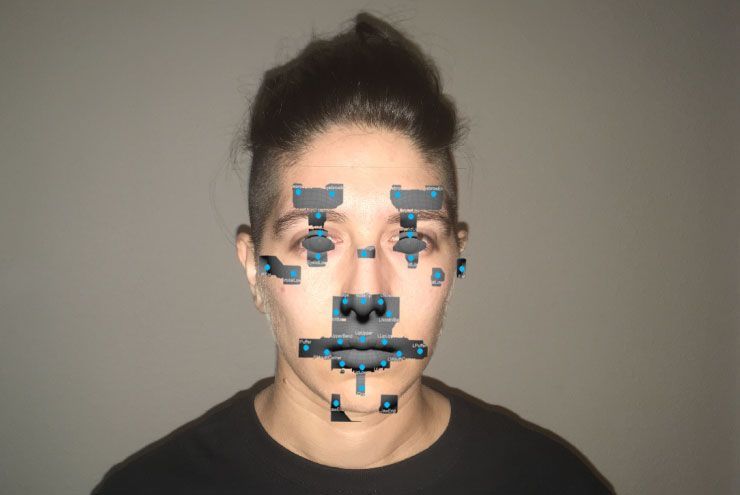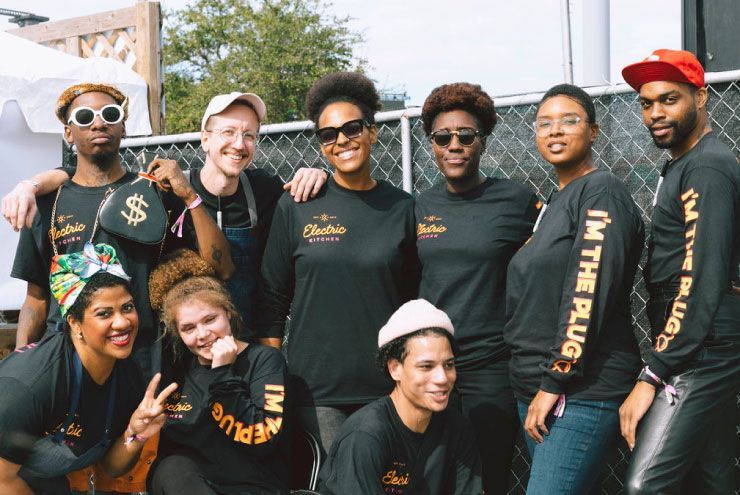By Liz Sholar
While most of us understand that gender is performative, few consider gender to be art. More so, gender can be used as a tool within that performance. And by its most basic definition, a tool can be understood as technology.
Dallas-based artist S Rodriguez sees “gender as a technology, both in a precolonial, colonial and postcolonial state. Gender plays a role in the way you operate in society. It is very much a tool, just like any technology, that you can choose or is chosen for you. And you can choose to continue working with that tool or change that tool.” While for some, the “goal” of gender as a tool might be “passing,” for Rodriguez and many others who are gender nonconforming, the objective is more of a fluctuating target. “I’m going to exist in a certain way until I can’t anymore, or exist in a certain way until it no longer serves me,” says Rodriguez. “I don’t think technology is anything, and I don’t think it works toward any sort of goal either. Tech is created without anyone marginalized in mind… it’s mostly made by white, cis, het people. So, when it does finally trickle down into the public sphere, you have to edit it in more ways for it to be usable or functional for yourself, as any kind of marginalized person.”
Another way that gender and technology interact with one another is through the use of technological advances, or appropriations, to manipulate an individual’s gender presentation, essentially allowing one to “DIY a gender.” Rodriguez points out that a classic example of this is hormone replacement therapy, which was created with cis folks in mind. “It didn’t exist for trans people in the healthcare sense… But now, it’s like, ‘Oh, I’m going to use that and change my body based on what these hormones were intended to do for other people,’ so the usage of the tech is crafted around ourselves.”
This type of gender hacking takes place in the digital realm as well. Rodriguez feels that the Internet of the early 2000s was a more malleable place for gender nonconforming folks. “I’ve been an Internet user for a really long time,” they say. “I would just be whoever [I wanted] in the pre-social media era. In chatrooms, when people would say ‘ASL’ (age, sex, location), I’d just lie… I’d be a 17-year-old boy from California, when I was really like 12. You used to be able to mess around with it a lot more, in terms of publicly acting as any kind of gender, versus your assigned gender at birth or exploring gender nonconformity.”
Rodriguez recalls, in the early days of Facebook, there were only binary pronoun options, so they edited the code for the social media platform so that it recognized their profile as a band page and would therefore allow for they/them/theirs pronouns. “On the one hand, it didn’t evolve fast enough. On the other, once it did, the discourse kind of exploded… Like, ‘woah, nonbinary! So cool that that’s a thing!’ I remember in 2015, we got gay marriage, Facebook pronouns, identity labels, and suddenly everyone knew what it was. And I just felt like, ‘This is so weird,’ because I’ve been toiling in obscurity, not really having people believe me, or think it’s weird, but now that Facebook said it, it’s like, ‘I respect your identity.’” While they certainly contend that resources like a greater variety of pronoun options online are incredibly important, these advances do often make gender experimentation more difficult to achieve. “Performing gender on the Internet used to be way, way easier than it is now,” Rodriguez says. “You have this fixed-box identity where you check all the pronouns and identities that apply to you [and that tends] to be very stagnant… I do feel like it’s a very, very one-dimensional version of these identities, where you sort of plaster it across your face like, ‘This is me, for sure!’”
All of this navigation through gender, technology, and asserting one’s identity online is enough to contend with on its own, let alone adding the aspect of a global pandemic reframing the way we understand and relate to technology. “In one sense, I’m really excited because aspects of the ‘old Internet’ are coming back into fashion,” Rodriguez says. “Like, we can’t meet up in person, so now we have to stream a movie in Discord to hang out together… These certain things that used to be very online-based forms of communication or ‘hanging out’ are coming back, so that excites me.” Additionally, Rodriguez has enjoyed seeing the way that people are revisiting crafting identity online when they can’t be fully present in the physical world: “If you’re a college kid and you’re not out to your parents and then you have to move in with your parents, where can you be out? You can be out on the Internet, you can hang out on the Internet. So, I think that sense of being able to have an identity that you don’t use in the ‘real world’ but you do use on the Internet, is beneficial. This sort of technology has become beneficial in being able to be yourself and identify the way you want to identify, or progress in that identity.” While this crafting online may be a way to avoid compromising the safety of one’s “in-person life,” that in no way indicates that what is experienced online isn’t “real life.” The barrier between the physical and the digital is being broken down for us as we shift our thinking to adjust to the COVID-19 crisis.
Rodriguez’s artwork also serves as a means to break down audiences’ assumptions of “real life,” gender, and technology by bringing these concepts together in their projects. “I want to do more technologically obvious work, in the sense that I want to use more technology in the stereotypical sense of the word, like computers and coding. I’ve done some coding, I’ve done some sound editing, I’ve done a little bit of everything.” Recently, Rodriguez has been working with paint that conducts electricity, so that when it is touched, it signals the attached computer to prompt a sound created by the artist. Their 2019 piece entitled ENTER PLAYER was part of the All Shades Considered show at the Austin Public Library, and allowed viewers to interact with the work through touch and sound. This disrupts the typical, expected behavior associated with viewing an artwork, drawing the audience to connect with the piece rather than merely observing it. Rodriguez has also created a set of acrylic nails using conductive paint and has plans to explore wearable art as a means of commenting on our relationship to technology and surveillance in the future.
One of the greatest challenges faced by the artist is that of the audience—not everyone is prepared to grapple with the ideas that Rodriguez is presenting, or even to accept the artist’s identity. “Audience members will often ask really weird questions or not attribute my work to me,” says Rodriguez. “Most of my work has some kind of text element in it, and people almost every single time will be like, ‘Wow, is that found text?’ No, I wrote it. I wrote it all. There’s always that element of, ‘Oh, you must be plagiarizing; oh, you must be hiding something.’ And I do have these sound installations where I write the text and I record it and I edit it, and people still ask, ‘What’s the sound from?’ I made all of it, it says my name.” While the idea of pulling found texts or using auditory samples in artistic work is common, it is much more accepted when done by white, cis artists. Rodriguez has found that, as a queer, Latinx artist, using those methods is simply not possible. “Which is why I never do it,” they say. “It would ruin everything. So, everything that’s written is mine, and doing otherwise would delegitimize it.” Whether it’s navigating the art world, technology, or gender itself, trans and gender nonconforming people have to work twice as hard as their cis counterparts to gain acceptance or simply exist in the world.
These issues aren’t just limited to patrons. Rodriguez has faced a series of microaggressions when working with artistic institutions as well. “I do feel like people’s inherent biases come out in really weird ways,” they say. “I had a show and the gallery I was in didn’t print my work on opening night. And everyone else had their work printed. Like, where is mine? I’ve also had lots of events where there will be a flyer and my name won’t be on it, they’ll be like, ‘Oh, sorry we have to fix that.’ It’s weird, to slip under the cracks in these really insidious ways, and I know why. It’s because I’m Latinx and I’m trans. It can’t be anything else because it happens every single time and there’s only one thing in common and it’s me.” While Rodriguez has experienced “good luck” with their pronouns being respected by institutions, they say, “it kind of stops there, which is maybe even less than the bare minimum.”
In addition to these issues, Rodriguez feels that most group shows are lacking in queerness and authentic representation: “I don’t know that I’ve been to a ‘queer show’ where I was like ‘Wow, that was done really well.’ I just wish people would step out of the way and be like, ‘We’re hiring a queer curator and we’re just going to step back.’ But even then, it’s not like every queer person is the same and it’s a lot more complicated than that.” Understandings and operations of gender are going to be as innumerable as queer people themselves, and this conversation goes to show how difficult it is to define, let alone contain, the diversity and depth of imagination present in challenging the gender binary through art and technology. We all construct and perform gender as we move through the world, and serving as advocates for trans and gender nonconforming people is crucial to bring about an environment in which their safety is a reality, not just something achieved through hacking technology or imagined through the lens of art.







